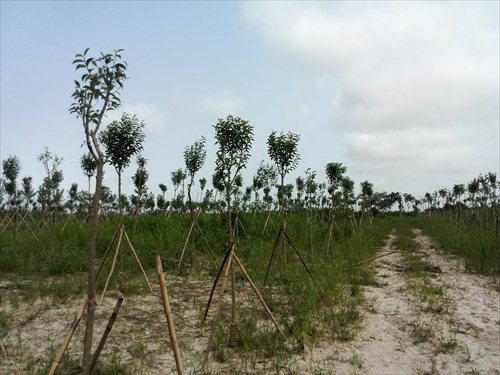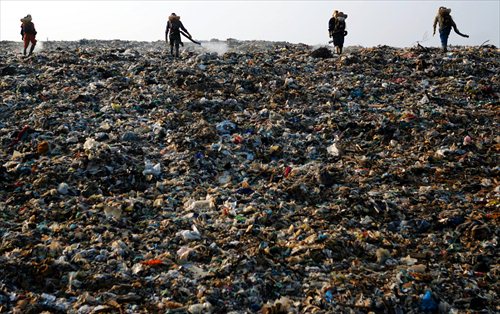HOME >> METRO SHANGHAI
Shanghai’s largest refuse landfill becomes a flowering parkland
By Du Qiongfang Source:Global Times Published: 2016-1-18 17:28:01

Today Laogao is being turned into a garden. Photo: Courtesy of the Shanghai Academy of Landscape Architecture Science and Planning
The Laogang Refuse Landfill near the East China Sea in Pudong New Area used to be a bleak, stinking area best avoided. But these days it's being turned into an attractive park where trees, flowers and greenery will flourish.
At this landfill scientists from the Shanghai Academy of Landscape Architecture Science and Planning are undertaking research into soil refilling, ecological environment restoration and topography. The researchers hope that over the next five to 10 years the garbage landfill site will become one of the city's prime parks.
With rapid urbanization, how refuse landfills affect the environment and how these landfills can be regenerated with vegetation, have become pressing environmental problems around the globe. Landfill is the most common method of garbage treatment internationally including China.
But because garbage landfills need large areas of land and cause serious soil, air and water pollution, understanding sealed garbage landfills, revegetation and landscaping have become very important to urban environmental management.
Still growing
Shanghai has been undergoing rapid urbanization and a burgeoning population since 1990. The amount of garbage the city produces has also been increasing and now grows at an average 3 to 5 percent annually.
At present Shanghai has to treat more than 10,000 tons of garbage every day. In the summer of 2013, the daily amount of garbage treated amounted to nearly 20,000 tons - large amounts are now treated before being buried.
Shanghai has more than 200 refuse landfills that remain barren and unimproved. And there is the Laogang Refuse Landfill, the largest in Asia. It covers around 14.67 square kilometers and keeps more than 70 percent of the household garbage produced in Shanghai.
The shallow topsoil covering a sealed landfill is not rich or deep enough to grow trees and shrubs - only weeds and goldenrod wildflowers seem to flourish. A bare landfill site suffers serious soil and water loss and this is why revegetation and afforestation have become important.
Shanghai has a limited amount of land and limited space for any significant afforestation. It was also the most populous city in the country and the first to develop and then discover that, comparably, it was falling behind other cities in the world for afforestation
By the end of 2013, although the total afforested area in Shanghai was 1,007 square kilometers, and the forest coverage rate reached 13.13 percent this was much lower than that of other cities like New York, London, Paris or Tokyo. It was also 8.5 percent lower than the national average forest coverage rate. By 2015 Shanghai's forest coverage rate had risen to 15 percent and local authorities have set an 18 percent forest coverage target for the city by the end of 2020.
To extend the potential of the city's ecological spaces, Shanghai authorities have planned to increase afforestation in areas with special ecological situations.
Success stories
Overseas there have been several success stories of ecological restoration and landscape reconstruction on refuse landfills, like the refuse landfill in Montreal, Canada. The landfill area there has become beautiful parkland after years of planning and greenery restoration. This has been an inspiration for Shanghai.
In 2002, a research team from the Shanghai Academy of Landscape Architecture Science and Planning began studying revegetation and ecological technology for landfills. In 2003, the research team reformed the Minhang Sports Park refuse landfill, turning 120,000 square meters of construction garbage landfill into an attractive park. In 2008 they began researching how to renovate household garbage landfills.
The big problem with afforestation and revegetation is the lack of topsoil. In sealed landfill areas the topsoil was usually only 20 to 30 centimeters deep which is not enough to grow most plants or trees. When the scientists increased the depth of the topsoil to 80 centimeters it became viable for the growth of shallow-root plants. Improved soil quality is also vital for afforestation. Laogang is close to the East China Sea and soil in the area is slightly alkaline with pH values ranging between 8.6 and 9.1. But the best soil pH value for plants is around 7.8. As well the fermentation, temperature and the gases produced in the landfill soil can all badly affect attempts at afforestation.
After trial and error, the scientists found the quickest way to improve soil quality was to cut and bury the goldenrod wildflowers. Burying these along with organic waste and water hyacinth made the soil more suitable for growing other plants.
In a research base at Laogang, scientists experimented with soil and plants seeking to establish the most attractive and the hardiest plants that could resist drought and wind and absorb pollutants.
In June 2014 in Laogang an afforestation project covering 5.07 square kilometers was launched. Last February, familiar hardwoods and evergreen trees like Chinese tallows and privets were planted. To ensure they would withstand the strong sea winds common in that area, the scientists selected 3- or 4-year-old trees and tried different methods of bracing the trees as they grew.

Flashback: the old Laogang Refuse Landfill when it kept more than 70 percent of the household garbage produced in Shanghai Photo: CFP
90 percent survived
Even with the intense heat and sunlight of last summer, these trees managed a survival rate of 90 percent and remained unaffected through the typhoon season last year. Today the barren landfill in this area has partially been replaced by trees and greenery.
The soil restoration and afforestation is just the first phase of this project. In the second phase, scientists will add more color to the park. At the base, scientists are breeding different flowers which could prove suitable for the landfill site. Key blooms that have proved themselves so far include burclover and hibiscus. In the future, the scientists will also introduce water plants and, when the trees grow larger, they will add flowering plants around the root areas.
The project will eventually produce a park with hills and wetlands with a diverse ecological content. Over the next five to 10 years it will become one of Shanghai's more attractive parklands.
Compiled by Du Qiongfang based on a Xinmin Evening News report
Newspaper headline: A garden from garbage
Posted in: Metro Shanghai, City Panorama